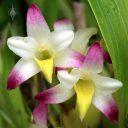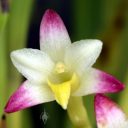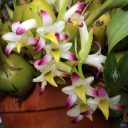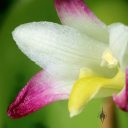As the BBC reports, chikanda is a traditional food in parts of Zambia __and Tanzania, made from the tubers of local orchids. These tubers look like little potatoes. They are cooked with peanuts __and chilies into savory cakes resembling meatloaf, and called chikanda. Swedish botanist Sarina Veldman has been studying the DNA of tubers for sale in African markets, and has found over 80 different species. These include many different types of Disa, Habenaria, and Satyrium orchids. Unfortunately, increasing commercial demand and habitat loss are endangering these local orchids. As collectors go farther, neighboring countries are also losing many of their native terrestrial species. Veldman and other scientists are hoping that sustainable practices, like bringing the orchids into cultivation, will reduce pressures on wild plants. Some steps have already been taken, such as the creation of Kitulo National Park in Tanzania, which protects an area of rich botanical diversity known as the “Serengeti of Flowers.” Scientists and local peoples will need to work together to find more solutions to conserve these fascinating orchids and this popular snack food.
, ,Pages
26 Nov 2016
22 Nov 2016
Wild Orchids Bloom Across Australian Capital
The Sydney Morning Herald reports that tens of thousands of wild orchids have bloomed around Canberra. After a very wet winter across the Australian Capital Territory, dozens of different orchid species are putting on a show. With common names like Donkey Orchids, Beard Orchids, __and Helmet Orchids, they have a myriad of fascinating sizes __and shapes. Government conservation officer Dr. Michael Mulvaney added “There are as many orchids [species] on Black Mountain than there are in the whole of Great Britain so we’re blessed by our diversity of orchid.”
, ,19 Nov 2016
A Beautiful Coelia Orchid
Coelia bella is a great orchid species, both easy to grow __and easy to pronounce. Its charming purple, white, __and yellow flowers give off a light marzipan or almond oil fragrance.



To say Coelia, ignore the “o” and say Celia like the woman’s name, SEE-Lee-Ah. The second part of its Latin name, bella, translates as beautiful. In the wild, this species lives from southern Mexico through Central America in rainforests up to 5000 feet (1500 m) in elevation.






In addition to its lovely flowers, this orchid is also known for its distinctive, egg-shaped pseudobulbs (some of them look more like fat tomatoes than eggs!) My plant happily grows outdoors all year in a partly sunny area next to our house. I give it regular water, fertilizer, and a winter dormancy. This variety can handle a wide range of temperatures. It needs extra care during repotting to avoid damage to roots. The last photo below shows two fat pseudobulbs and a flower spike hanging out of the pot, indicating that my plant is overdue for repotting. But that obviously hasn’t slowed down the flower show on this beautiful Coelia.



14 Nov 2016
Saving Minnesota’s Rare Orchids Before It’s Too Late
The Minnesota Landscape Arboretum is working to conserve rare native orchids. The Arboretum is building a seed bank for all of the state’s 48 native species, including the official state flower, the Showy Lady’s Slipper. The effort is part of a larger conservation project, headed by the Smithsonian Institution, to preserve seeds from all of the USA’s native orchids. Since many of these orchids are rare, __and their seeds are as small as dust, collecting them is a real challenge. “A lot of orchids are the first species to disappear from a landscape,” said plant expert David Remucal. “We could be losing a lot of these landscapes over the next 50 years, so we could be losing a lot of these orchid populations.”
, ,7 Nov 2016
Orchids on the Rocks
Orchids on the rocks? No, it’s not another post about ice cubes or climate change. Instead, it’s about orchids which actually grow on rocks. Attached by their roots, orchids may wedge into stony crevices or hang off sheer mountain cliffs. Many orchids which are air plants can affix to both trees __and rocks. The first three photos show a few species which can grow this way: a Dendrobium, a Laelia, __and a Sarcochilus.



Plants which grow on rocks are called lithophytes. Gardeners may also hear the word rupicolous, which has the same meaning. Lithophytes in the orchid family include some Lady Slippers, Dendrobiums, Sarcochilus, Cattleyas, Bulbophyllums, Oncidiums, Angraecums, and many more. Their roots cling to rough stone surfaces, and expand into cracks and crevices to help secure themselves. They may live in pockets of soil or rotting leaves which provide them with nutrients. Some of the pictures below show how their white roots attach to rocks.






Keeping orchids as lithophytes can be tricky. Rock can quickly heat up in direct sun, and flat areas may not drain well, so it’s important to pay careful attention to light, water, and humidity. The standard advice is to grow lithophytes like air plants, keeping them in well-drained pots with bark or moss, rather than risking them on stone. For the adventurous, Growing Orchids in Your Garden by Robert G.M. Friend has a chapter on lithophytes, including which varieties work best.



For more photos of orchid on the rocks, check out this blog post about plants in Cambodia.
, ,1 Nov 2016
November Orchid Shows
From Santa Barbara to Paris to Tasmania, don’t miss these opportunities to see wondrous flowers, take photos, talk with orchid experts, __and purchase plants.